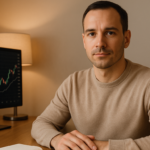Why do investors struggle with portfolio rebalancing? Emotional decisions. Behavioural finance shows us how biases like loss aversion, overconfidence, and herd mentality derail disciplined strategies. For instance, fear of “locking in” losses often stops investors from selling underperforming assets, while recency bias tempts them to chase market winners.
The solution? Systematic rebalancing. By sticking to predefined rules and leveraging tools like automation, investors can avoid emotional pitfalls, keep portfolios aligned with their goals, and improve long-term returns. Studies reveal that portfolios rebalanced annually outperform unmanaged ones, with gains up to 0.56% annually over a decade.
For Singapore investors, tools like CPF and SRS contributions, combined with local platforms offering automated rebalancing, simplify the process and reduce costs. Learning from experts like Collin Seow can also help you develop disciplined strategies to sideline emotions and focus on logic.
Main Behavioural Biases That Affect Portfolio Rebalancing
Psychological biases can derail disciplined rebalancing, often leading to poor investment decisions that magnify risks.
Loss Aversion and Market Volatility Reactions
Loss aversion is a major obstacle to effective rebalancing. This bias means investors feel the sting of losses about twice as strongly as they enjoy equivalent gains. When markets get turbulent, this heightened sensitivity can delay crucial rebalancing actions.
Take Singapore investors as an example. When asset values drop, the fear of “locking in” losses often stops them from selling underperforming investments, even when rebalancing strategies call for it. Holding onto these assets beyond their intended allocation increases portfolio risk and undermines the core principle of rebalancing: “sell high, buy low”. Research shows that an asset class that performed well last year has a 40% chance of underperforming the next year, yet loss aversion can blind investors to such patterns.
Following the Crowd and Peer Pressure
Social influence also plays a significant role in steering investors off course. Conversations with colleagues or friends about market trends can lead to deviations from a well-thought-out asset allocation plan. During bull markets, the urge to jump on the bandwagon might result in an overweight position in a popular sector. On the flip side, in a downturn, collective panic to sell could push investors to abandon their rebalancing strategies, potentially locking in losses and missing out on undervalued opportunities.
Anchoring and Recent Event Bias
Anchoring bias – where decisions are overly influenced by the original purchase price – can make portfolio adjustments difficult. For instance, if someone bought Singapore bank stocks at S$30 per share, they might hesitate to sell, even when the portfolio requires rebalancing.
Recent event bias is another common pitfall. Investors often place too much emphasis on short-term market movements. For example, after a strong quarter for Singapore REITs, an investor might significantly increase their property investments, straying from their long-term allocation plan.
These biases not only affect individual decision-making but also highlight the importance of systematic rebalancing to safeguard portfolio performance. Next, we’ll explore how these tendencies impact returns and how structured strategies can help investors stay on track.
How Behavioural Biases Hurt Portfolio Performance
Letting emotions dictate investment decisions can disrupt wealth-building efforts and destabilise portfolios.
Problems with Emotional Rebalancing Decisions
One major issue is portfolio drift. This happens when investors let emotions take the wheel, causing their carefully planned asset allocations to veer off course. For example, a Singaporean investor might start with a balanced allocation of 60% equities and 40% bonds. But after a strong rally in local bank stocks and REITs, that equity exposure could balloon to 80%. Why? Overconfidence or fear of missing out often play a role.
This drift isn’t just a numbers game – it comes with real risks. Research shows that failing to rebalance regularly can chip away at returns over time. On top of that, an overconcentrated portfolio becomes highly vulnerable during market downturns, leading to sharp value swings that might push investors to sell in panic.
Another pitfall of emotional rebalancing is that it undermines the tried-and-true “sell high, buy low” principle. Instead, investors often chase after assets that are already performing well and hold onto underperformers. Timing also tends to be poor, with rebalancing decisions made during moments of market chaos or euphoria.
These challenges highlight why systematic rebalancing is a better alternative, as shown in the comparison below.
Systematic vs Emotional Rebalancing Comparison
The differences between these two approaches become strikingly clear when you look at their long-term impact:
| Aspect | Systematic Rebalancing | Emotional Rebalancing |
|---|---|---|
| Decision Making | Follows predefined rules and schedules | Driven by market sentiment and fear/greed |
| Portfolio Allocation | Keeps allocations aligned with targets | Allows significant drift from the original plan |
| Risk Management | Matches risk to the investor’s tolerance | Creates unpredictable risk exposure |
| Performance Impact | Delivers better returns over 10 years | Leads to weaker returns due to poor timing |
| Volatility | Reduces volatility with diversification | Increases volatility from concentrated positions |
| Transaction Costs | Keeps costs low with planned trades | Raises costs through frequent, impulsive trading |
| Stress Level | Lowers stress with a disciplined approach | Heightens stress from constant market monitoring |
Adding to this, there’s a 40% chance that last year’s best-performing asset class will end up losing ground the following year. Emotional investors, often influenced by recent performance, might pour more money into these “winners” just as they begin to falter. In contrast, systematic rebalancing ensures consistent allocation, ignoring short-term trends.
Over time, the differences between these approaches add up. While emotional rebalancing may feel more reactive, the evidence shows that systematic strategies deliver better risk-adjusted returns, smoother performance, and stronger alignment with long-term financial goals. It’s a compelling case for adopting disciplined rebalancing to counteract behavioural biases.
Master Systematic Trading with Collin Seow
Learn proven trading strategies, improve your market timing, and achieve financial success with our expert-led courses and resources.
sbb-itb-466c9b0
How to Reduce Behavioural Biases in Rebalancing
Tackling behavioural biases starts with a disciplined rebalancing plan that aligns with long-term financial goals. Below are practical ways to simplify rebalancing and keep emotions in check.
Creating Clear Rebalancing Rules
The first step to avoiding emotional pitfalls is setting predefined rules before emotions take over. These rules ensure decisions are guided by logic, not impulse.
Begin by defining your strategic asset allocation – for instance, 60% equities and 40% bonds, or whatever mix suits your risk tolerance and investment goals. Set clear tolerance thresholds, such as a 3% deviation, to trigger rebalancing actions. This keeps your portfolio aligned with your targets without overreacting to market swings.
“Success in trading is not just about making decisions; it’s about making informed decisions. Collin Seow’s trading methodology stands out through its systematic and strategic approach, particularly in addressing the critical aspects of trading: what to buy, when to buy, and how much to buy.”
Stick to a regular schedule – quarterly or annually – for rebalancing. Additionally, you can establish predefined triggers, such as rebalancing whenever an asset class deviates by more than 5 percentage points from its target allocation. These clear, mathematical criteria ensure that rebalancing is driven by logic, not emotional reactions to market volatility.
Using Automation and Technology Tools
Technology can help you stay disciplined. Automated rebalancing systems and robo-advisors offered by Singapore banks and fintech platforms can monitor your portfolio and make adjustments based on your preset rules, removing the need for manual intervention. This reduces emotional stress, especially during volatile markets.
Modern AI-driven tools are particularly useful for detecting behavioural biases. They provide data-driven prompts to help you avoid common traps, like chasing recent winners or holding onto underperformers. These tools act as a helpful nudge, keeping you aligned with your long-term strategy.
For Singapore investors, another effective approach is to use cash flows strategically. Instead of selling existing assets, direct new contributions towards underweight asset classes. This method not only keeps transaction costs and taxes low but also reduces the emotional hurdles often associated with selling investments.
Learning and Getting Professional Help
Beyond rules and automation, increasing your knowledge and seeking professional guidance can further reduce biases.
Understanding your own emotional triggers is key. Keeping a simple investment journal can help you identify patterns in your decisions and spot recurring biases. Self-awareness is a powerful tool in making better financial choices.
Continuous learning is equally important. Platforms like Collin Seow Trading Academy offer resources such as trading courses, free e-courses, and live webinars to teach systematic trading strategies. Their book The Systematic Trader v.2 and free video lessons provide valuable insights into managing behavioural biases for improved outcomes.
“His approach is not just about making successful trades but about cultivating a disciplined, informed, and strategic mindset among his students.”
Professional advisors can also play a crucial role. They provide objective advice during market turbulence, helping you stay focused on your long-term goals. Their accountability makes it harder to abandon your systematic approach when emotions are running high.
Behavioural coaching is gaining popularity among financial advisors. These professionals help clients understand their biases and develop strategies to manage them effectively. Joining investment groups or online communities focused on systematic investing can also reinforce good habits and provide support during challenging market conditions.
Ultimately, behavioural biases affect everyone – even seasoned fund managers. The difference lies in having systems, tools, and support to counteract these tendencies. By combining clear rules, automation, and continuous education, you can turn rebalancing into a disciplined process that keeps you on track for long-term success.
Resources for Singapore Traders
Singapore Portfolio Management Considerations
Investors in Singapore operate within a unique financial landscape, which requires attention to specific local factors when applying systematic rebalancing strategies. For starters, the Singapore Dollar (SGD) serves as the base currency for domestic investments. However, many investors manage both local and international portfolios, which introduces currency exposure into the mix.
Singapore’s Central Provident Fund (CPF) and Supplementary Retirement Scheme (SRS) offer tax-efficient ways to rebalance portfolios. Instead of selling off overweight assets and incurring transaction costs, investors can direct their CPF and SRS contributions toward underweight asset classes, making it a cost-effective strategy.
The Monetary Authority of Singapore (MAS) ensures strong investor protection through its regulatory framework. However, behavioural tendencies like home bias – overinvesting in familiar domestic assets – can hinder international diversification and increase risks. Addressing this bias is crucial, especially for those using commission-free ETF trading platforms available in Singapore. Educating investors on systematic and disciplined strategies is key to navigating these challenges effectively.
Collin Seow Trading Academy: Systematic Trading Education

For Singapore traders aiming to overcome behavioural pitfalls, the Collin Seow Trading Academy offers tailored education in systematic trading. Established by Collin Seow, a Chartered Portfolio Manager (CPM) and Certified Financial Technician (CFTe) with over 13 years of trading experience, the academy focuses on disciplined trading strategies.
The academy’s approach tackles psychological biases with a clear, structured methodology:
- What to buy: Using “comparative strength” – a mathematical formula combined with fundamental analysis – traders identify strong stocks. This approach considers factors like industry position, revenue growth, and catalysts, helping reduce reliance on subjective opinions or herd behaviour.
- When to buy: By combining technical analysis with market trends, traders can pinpoint optimal entry points. This method minimises impulsive decisions driven by emotions like fear or greed.
- How much to buy: Traders learn to size positions strategically based on their risk tolerance and the trade’s risk-reward profile. This promotes rational decision-making and avoids emotional overcommitment or undercommitment.
“Success in trading is not just about making decisions; it’s about making informed decisions.”
- Collin Seow
The academy offers a variety of learning resources, including trading courses, free e-courses like “Market Timing 101”, live webinars such as “Systematic Trading Profits”, and educational materials like the book ‘The Systematic Trader v.2’. These resources aim to instil discipline and structure in traders, helping them manage behavioural biases effectively.
Why Systematic Strategies Work for Singapore Investors
Systematic strategies are particularly effective for Singapore investors because they remove emotional decision-making from the equation. By addressing common pitfalls like behavioural biases, these strategies create a foundation for long-term success. Research has shown that portfolios with at least 45% stock allocation and annual rebalancing consistently outperform those left unmanaged over 20 years.
Automated rebalancing systems and robo-advisors play a significant role in this process. They monitor asset allocations and make adjustments based on preset rules, eliminating the hesitation and second-guessing that often accompany manual rebalancing. The rebalancing process typically takes up to 7 business days, during which overweight positions are reduced, and proceeds are reinvested in underweight areas to restore balance. Platforms also utilise dollar-cost averaging to spread larger adjustments over time, reducing the impact of market volatility and timing risks.
The value of systematic education is underscored by endorsements from local professionals:
- Chris Isaiah, Executive Director of Pioneers & Leaders Pte Ltd, shares, “Genuine and generous with his ideas. His humility has made him a great and trustworthy person.”
- Moonshi Mohsenruddin, CEO of Commgate (S) Pte Ltd, adds, “Very knowledgeable and experienced in stocks and shares. I recommend Collin if you are planning to grow your portfolio and want someone to advise you.”
Conclusion
Behavioural finance plays a crucial role in shaping portfolio rebalancing decisions, often disrupting even the most well-thought-out strategies. Research consistently shows that systematic rebalancing tends to outperform unmanaged portfolios over the long term. This highlights the value of sticking to disciplined methods instead of letting emotions take the wheel.
To navigate psychological biases, investors benefit from systematic strategies that rely on predetermined rules and automation, eliminating the need for subjective decisions. For investors in Singapore, blending local market insights with strategic use of CPF and SRS contributions, while leveraging commission-free ETF platforms, can offer a cost-efficient way to rebalance portfolios without succumbing to emotionally driven choices.
The Collin Seow Trading Academy demonstrates how structured education can reshape investment habits. By teaching clear, rule-based approaches – covering what to buy, when to buy, and how much to invest – the academy provides investors with the tools to sideline emotions and stick to rational, effective strategies.
FAQs
How can Singapore investors use their CPF and SRS funds to rebalance their portfolios efficiently while keeping costs low?
Singapore investors can make the most of their CPF and SRS contributions by using them strategically to adjust and diversify their portfolios. By allocating these funds into a mix of investments that align with their financial goals, they can achieve a more balanced approach to wealth building.
To keep costs in check, it’s a good idea to consolidate trades and limit portfolio reviews to semi-annual or annual intervals instead of making frequent changes. This not only reduces transaction fees but also helps avoid overreacting to short-term market fluctuations.
Another way to optimise your investments is by focusing on options with lower fees, like ETFs or index funds. These provide broad market exposure without the higher costs associated with actively managed funds. As you invest, make sure your portfolio reflects your risk tolerance and long-term financial aims. And don’t forget – CPF and SRS contributions come with tax benefits that can further enhance your overall returns.
How do automated rebalancing systems and robo-advisors help reduce behavioural biases in investing?
Automated rebalancing systems and robo-advisors are game-changers when it comes to tackling behavioural biases like overconfidence, loss aversion, and emotional decision-making. By relying on algorithms and structured processes, these tools take the guesswork – and emotions – out of portfolio adjustments. Instead of reacting impulsively to market swings, changes are made based on clear, pre-set rules.
For investors in Singapore, this approach ensures decisions are made with objectivity. It helps maintain the right asset allocation and keeps long-term financial goals on track. Plus, these systems save you the hassle and stress of manually rebalancing your portfolio, freeing up time to focus on other areas of your financial planning.
What are the differences between systematic and emotional portfolio rebalancing in terms of long-term performance and risk management?
Systematic rebalancing takes a structured, rule-based approach to managing your portfolio. By consistently adjusting your investments to match your goals and risk tolerance, it helps you avoid the pitfalls of emotional decision-making – especially during periods of market turbulence.
In contrast, emotional rebalancing is often reactionary, driven by gut feelings or market events. This approach can lead to inconsistent choices and heightened risks. Over time, sticking to a systematic method tends to yield steadier, more reliable results. It keeps your portfolio balanced and shields it from the worst effects of market swings. By staying disciplined and objective, you can enhance both the performance and risk management of your investment strategy.












